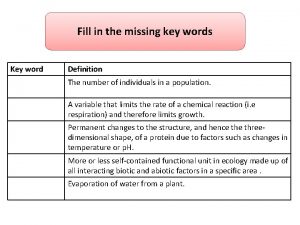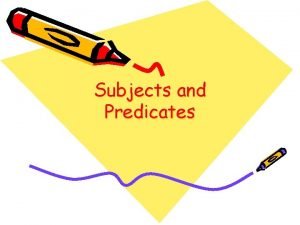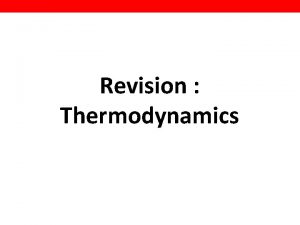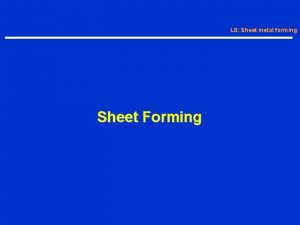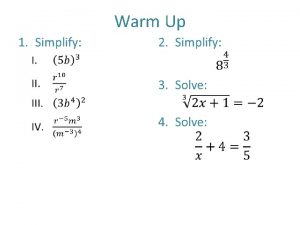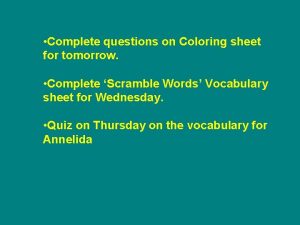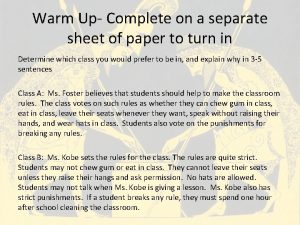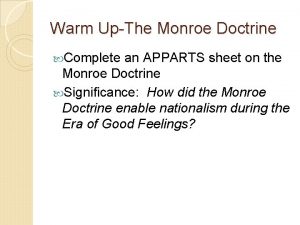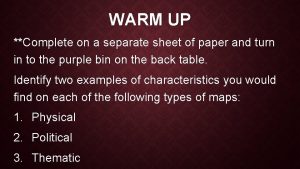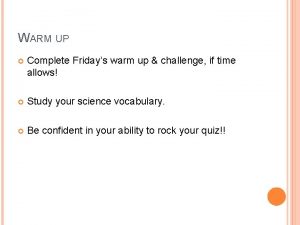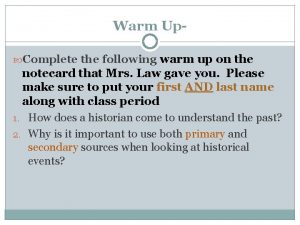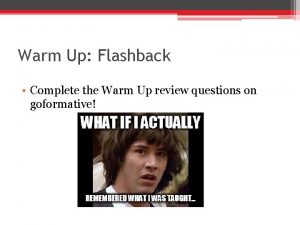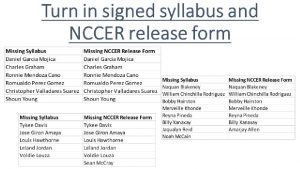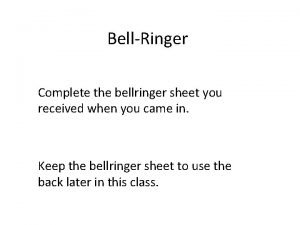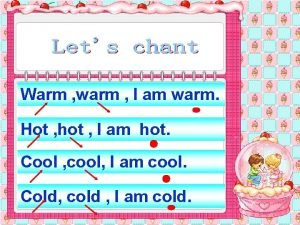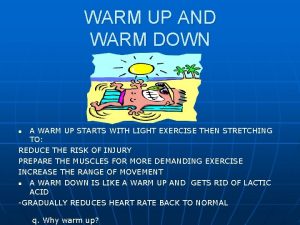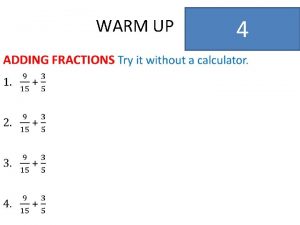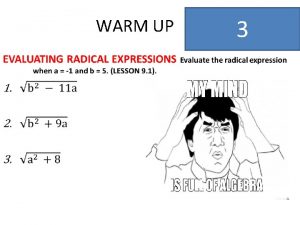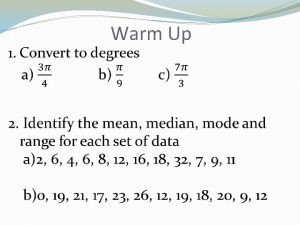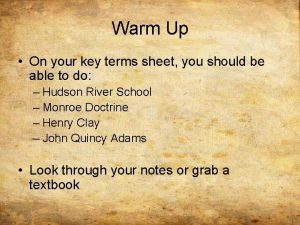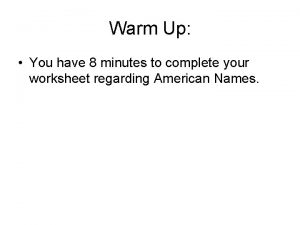Warm Up Complete this on the sheet you







































- Slides: 39

Warm Up Complete this on the sheet you picked up (Table with # 1 -5) 1. What are 3 of the Lab Safety Rules? 2. What are the procedures to deal with broken glass? 3. What are the consequences for not turning in the lab safety agreement? 4. What is a hypothesis? 5. Why haven’t you signed up for the class website? !

Unit One – Scientific Thinking and Connections in Biology

1. 1 What is Science? � Science is NOT just a collection of facts, concepts and useful ideas, but rather a method of investigating nature and discovering reliable knowledge. � Reliable knowledge is knowledge that has a high probability of being true because it has been justified by a reliable method.

There are three critical components to reliable scientific/critical thinking. � The use of empirical evidence – evidence you can experience (see, hear, etc) and that can be repeated, versus circumstantial evidence, testimonial evidence and authoritarian evidence � The practice of logical reasoning – requires careful analysis of evidence before: �Deductive reasoning – drawing conclusions based on evidence �Inductive reasoning – expanding on conclusions � The use of skepticism – constant questioning of the source and reliability of your beliefs and conclusions, holding beliefs tentatively, requiring adequate evidence or reason (Schafersman, 1997).

Practice with Graphing By yourself: �Complete Graphing with Scientific Data Practice Sheet (8 minutes) With a partner: �Compare answers (1 minute) Questions? Raise your hand silently!

Summary and example: The Scientific Method collects data using the critical analysis traits that scientists value. Summary and example: Summary and example:

Scientific Method Presentations Group One: describe independent and dependent variables. Explain the differnence between them Group Two: Explain the procedure for setting up a experiment. Describe the control and experimental groups Group Three: Provide the “rules” for good data using examples Group Four: Define “good science. ” Explain the difference between theories and laws

YOU HAVE HOMEWORK: 1. UNIT 1, MODULE 1 PROBLEM SET #110 2. FINISH THE PAPER TOWEL LAB Warm Up 1. In your own words, define science 2. What is changed in an experiment a. Dependent Variable b. Independent Variable c. Control Group 3. Why do you need a control group in an experiment? 4. What is the next step when your hypothesis is rejected? 5. Draw a graph and label the x and y axis


Paper Towel Lab! Listen to Ms. S for directions! Roles: 1. Student with the closest birthday: Read directions and make sure experiment is performed correctly 2. Tallest student: Gather lab materials & pour water 3. Shortest student: Write down data in tables 4. Remaining student: Keep track of time and perform any calculations

Group Work! �Complete Scientific Method Worksheet with a partner �That partner must have the matching part of the story! (One person will have a picture of Patrick, the other will have Spongebob)

Exit Ticket Alex is studying the effect of sunlight on plant growth. His hypothesis is that plants that are exposed to sunlight will grow better than plants that are not exposed to sunlight. In order to test his hypothesis, he follows the following procedures. He obtains two of the same type of plant, puts them in identical pots with potting soil from the same bag. Then he puts one plant in the sunlight and the other in a dark room. He waters the plants with 200 m. L of water every other day for two weeks. Identify the 1. Independent Variable 2. Dependent Variable YOU HAVE HOMEWORK: 3. Control Group 1. UNIT 1, MODULE 1 PROBLEM SET #1 -10 4. Experimental Group 2. FINISH THE PAPER TOWEL LAB 5. Constants

TURN IN YOUR HOMEWORK! Warm Up 1. Write the 6 steps of the Scientific Method 2. How did we use the scientific method yesterday? 3. What is the difference between a law a theory? 4. What is an experimental group? 5. Which paper towel brand was the most absorbent in your experiment?

� What does Biology study? Science is divided into disciplines that examine different components of the natural world. Biology is the study of life. The smallest unit of life is a cell. Some organisms are multicellular and consist of tissues, organs and organ systems. In order to understand cells, we need to know what they are made of. EVERYTHING, living or non-living is made of matter. The smallest unit of matter is an atom. Multiple atoms are held together by bonds to form both small and large molecules.

� The matter in the universe is arranged in repeating units that give each set of matter unique characteristics. All matter is composed of atoms of elements. Important elements to life include Carbon, Hydrogen and Oxygen. Other important elements are abbreviated as CHNOPS.

� These elements bond together by sharing electrons to form molecules. ▫ Molecules can be grouped as organic (contains CHO) or inorganic. The most important inorganic molecule is water. � All life is carbon-based and there are four important organic macromolecules needed to build cells. � We will discuss these later Summary:

What do you need to be considered living?

CARSMOG � made of Cells � Adapt � Reproduce � Stimulus and response � Metabolism � Organized � Growth

Station Activity 1. Using your Living, Nonliving, Dead worksheet, complete the table by moving from station to station (There are 12) 2. Noise should be at level 2 3. Ms. S will not take any questions. Use your classmates for help/opinions 4. When you are finished, take a seat and work on #20 -25 on the problem set (same sheet as your homework from last night!)

Exit Ticket 1. What does CARSMOG stand for? 2. What is the basic unit of life? In the experiment, “The effect of energy drink on the growth of a plant” 3. What is the independent variable? 4. What is the dependent variable? 5. What is the control group?

Warm Up 1. Write and describe 2 characteristics that are required to be considered living. 2. What is the most fundamental unit of matter a. Tissue b. Atom c. Cell d. Organ system 3. What are cells? 4. What is an independent variable? 5. Name one of the letters of STERNGRR and what is means

� 1. 2 Living organisms share many characteristics, such as having enzymes. These characteristics can be described in many ways, but one method is to list all the processes that living organisms perform. � Synthesis – organisms build body structures like hair and nails � Transport –organisms move things within their body, like using blood � Excretion – organisms get rid of solid, liquid and gas waste � Regulation – organisms control their body temperature

� Nutrition – organisms either make or consume food � Growth and development – multicellular organisms get bigger in a variety of ways � Respiration – organisms all need to break down carbs to get energy in the form of ATP, often using oxygen � Reproduction – organisms make offspring, either asexually or sexually Summary: Together these STERNGRR reactions and processes make up every organism’s metabolism. An organism will complete all 8 processes. Organisms also regulate their internal conditions in a process known as homeostasis.

� Living organisms share many characteristics, but they come in many different forms. Organisms can be grouped or classified into 6 main kingdoms based on their similarities and differences. � Eubacteria – a kingdom of simple unicellular organisms known as prokaryotes. These are the main bacteria you hear of like Staph, Strep and Salmonella. � Archaebacteria– a kingdom of simple prokaryotic unicellular organisms that live in extreme environments. They are even found living in the Dead Sea! � Protists – a kingdom of complex cells with a nucleus, but some are unicellular, some are multi. These include algae and brain-eating amoebas!

� Plantae – a kingdom of complex multicellular organisms who make their own food. They are divided into 4 main groups within this kingdom. � Fungi – a kingdom of complex organisms that consume their food extracellularly. These include mushrooms, molds and yeasts. � Animalia – a kingdom of complex organisms that move and consume food. � Some don’t fit…. Viruses!!! These organisms don’t have cells and don’t perform any of the life functions on their own. In order to survive, they must invade YOUR cells to reproduce!

WHEN YOU ARE DONE S T E R N G R R Finish Unit 1, Module 1 Problem Set ALL PROBLEMS And if you finish that? See Ms. S

Summary:

Exit Ticket 1. In your own words, define synthesis 2. What is homeostasis? 3. Why do organisms need energy? 4. What is the difference between adaptation and response? 5. Define biology

So we might have a fire drill… listen to Ms. S for instruction.

Warm Up 1. Name one of the 6 Kingdoms of Life 2. How are the experimental group and the control group different? 3. What is an example of a material that a plant would transport? 4. STERNGRR is used to explain A. Processes of living organisms B. Whether or not something is living C. How to maintain homeostasis D. How long a plant will live 5. How ready do you feel for this quiz?

Let’s Review! QUESTIONS? !

When you are done… -Fill out the vocab 1 sheet and rank the words from 1 -5 (read directions) -Relax, decompress -Do other work you might have As long as you hide your cell phones from an administrator that walks in, I don’t see them =) (and don’t tell your other teachers I let you use them…)

If you have finished the vocab sheet, go get a purple Biology book from the cabinet on the right side of the room (opposite the door) and look up terms!

Exit Tickets ● What is one of the 3 components to critical thinking? ● What are the steps to the scientific method? ● What is the difference between a dependent and independent variable? ● Write a hypothesis for this question: What will happen if you run a mile after eating 20 donuts? ● When does a scientist use the scientific method?

Alex is studying the effect of sunlight on plant growth. His hypothesis is that plants that are exposed to sunlight will grow better than plants that are not exposed to sunlight. In order to test his hypothesis, he follows the following procedures. He obtains two of the same type of plant, puts them in identical pots with potting soil from the same bag. Then he puts one plant in the sunlight and the other in a dark room. He waters the plants with 200 m. L of water every other day for two weeks. Identify the ● Independent Variable ● Dependent variable ● Control Group ● Experimental Group ● Constants

● What does CARSMOG stand for? ● What is the basic unit of life? In the experiment, “The effect of nicotine on the heart rate of a cat? ” ● The independent variable is ● The control group is

● ● Define synthesis in your own words What is homeostasis? Why do organisms need energy? What is the difference between adaptation and response? ● What does biology mean?

Unit 2 Vocabulary! Use your book!

Exit Ticket None =)
 Verification of stock in trade
Verification of stock in trade Complete the missing word to complete the three key words
Complete the missing word to complete the three key words Complete subject and simple subject
Complete subject and simple subject Hình ảnh bộ gõ cơ thể búng tay
Hình ảnh bộ gõ cơ thể búng tay Ng-html
Ng-html Bổ thể
Bổ thể Tỉ lệ cơ thể trẻ em
Tỉ lệ cơ thể trẻ em Chó sói
Chó sói Tư thế worm breton
Tư thế worm breton Hát lên người ơi alleluia
Hát lên người ơi alleluia Môn thể thao bắt đầu bằng chữ đua
Môn thể thao bắt đầu bằng chữ đua Thế nào là hệ số cao nhất
Thế nào là hệ số cao nhất Các châu lục và đại dương trên thế giới
Các châu lục và đại dương trên thế giới Công thức tiính động năng
Công thức tiính động năng Trời xanh đây là của chúng ta thể thơ
Trời xanh đây là của chúng ta thể thơ Mật thư anh em như thể tay chân
Mật thư anh em như thể tay chân 101012 bằng
101012 bằng Phản ứng thế ankan
Phản ứng thế ankan Các châu lục và đại dương trên thế giới
Các châu lục và đại dương trên thế giới Thơ thất ngôn tứ tuyệt đường luật
Thơ thất ngôn tứ tuyệt đường luật Quá trình desamine hóa có thể tạo ra
Quá trình desamine hóa có thể tạo ra Một số thể thơ truyền thống
Một số thể thơ truyền thống Cái miệng nó xinh thế
Cái miệng nó xinh thế Vẽ hình chiếu vuông góc của vật thể sau
Vẽ hình chiếu vuông góc của vật thể sau Biện pháp chống mỏi cơ
Biện pháp chống mỏi cơ đặc điểm cơ thể của người tối cổ
đặc điểm cơ thể của người tối cổ V. c c
V. c c Vẽ hình chiếu đứng bằng cạnh của vật thể
Vẽ hình chiếu đứng bằng cạnh của vật thể Tia chieu sa te
Tia chieu sa te Thẻ vin
Thẻ vin đại từ thay thế
đại từ thay thế điện thế nghỉ
điện thế nghỉ Tư thế ngồi viết
Tư thế ngồi viết Diễn thế sinh thái là
Diễn thế sinh thái là Các loại đột biến cấu trúc nhiễm sắc thể
Các loại đột biến cấu trúc nhiễm sắc thể Thế nào là số nguyên tố
Thế nào là số nguyên tố Tư thế ngồi viết
Tư thế ngồi viết Lời thề hippocrates
Lời thề hippocrates Thiếu nhi thế giới liên hoan
Thiếu nhi thế giới liên hoan ưu thế lai là gì
ưu thế lai là gì

